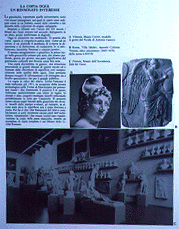

The Copy Today: A Renewed Interest
Collections of plaster casts, particularly those of universities, are veritable museums of the imagination. Here works of art can be arranged ideally, as in a textbook, exempt from the exigencies and problems that confront museums housing authentic antiquities.  At
the beginning of the 20th century, however, collections of casts fell
into disfavor, reviled as the cemeteries of art.
At
the beginning of the 20th century, however, collections of casts fell
into disfavor, reviled as the cemeteries of art.
Today this perception is changing. Copies--especially those executed in antiquity--have come to be regarded as treasures. They allow scholars to work around the problems of dispersion, destruction, and restoration of antiquities. Casts fulfill positive functions and possess their own inherent interest.
The new respect for replicas is justified in the first place by a growing realization that precious parts of the world's cultural patrimony are being lost to various well-known threats on a daily basis.
Many copies document conditions that predate the great disasters of this century. They remain immune to the alterations of surfaces that have compromised the quality of so many original works of art. Copies permit both specialists and the public to recover lost information and images.
Illustrations
- Venice. Museo Correr. Plaster model of the Paris of Antonio Canova.
- Rome. Villa Medici, Depot of the Column of Trajan, 17th century (1665-70), cast of Scene LXXVII.
- Florence, Museo dell'Accademia. Gallery of Plaster Casts.
Copyright ©1997, 2002 Ministero per i Beni Culturali e Ambientali, Soprintendenza Archeologica di Roma and the Kelsey Museum of Archaeology, University of Michigan. All rights reserved.
 |
 |
 |
 |
 |
 |
 |
 |
 |
 |
 |
 |